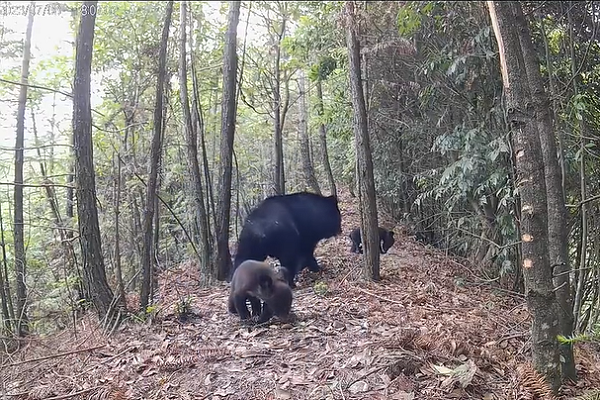Black bears recorded at Quzhou's Qianjiangyuan National Park

An adult black bear with two cubs is recorded by an infrared camera set up at the Qianjiangyuan National Park in Quzhou, Zhejiang province. [Photo/qz123.com]
An adult black bear walking with two cubs foraging for food was recently recorded by an infrared camera set up at the Qianjiangyuan National Park in Quzhou, Zhejiang province.
Based on the video, the adult black bear appears to be a female Asian black bear, and both cubs look to be about half a year old.
A black bear with children at the Qianjiangyuan National Park indicates that there is a relatively stable local black bear population in the area, said Li Sheng, a member of the bear specialist group of the International Union for Conservation of Nature (IUCN) and a researcher at the School of Life Sciences at Peking University.
This would not have been possible without the vigorous promotion of biodiversity protection by the Qianjiangyuan National Park Administration in recent years.
The Asian black bear is a national second-class protected wild animal. It requires a large activity space, eats a lot, and needs a high-quality habitat. The evergreen broad-leaved forests and deciduous broad-leaved forests on which it relies for survival are constantly decreasing or fragmenting, which is the main reason for the continuous decline in its population.
In June 2011, an infrared camera at the Kaihua Gutianshan National Nature Reserve took the first photo of a black bear in the wild in Zhejiang province. In 2014, another picture of a wild black bear was captured.
"The health of the black bear population shows the effectiveness of local environmental protection efforts. Only when protection work is effective can there be space for black bears to survive and reproduce," said Yu Jianping, director of the Research and Monitoring Center of the Qianjiangyuan National Park Administration.
In addition to black bears, Qianjiangyuan National Park's real-time wildlife monitoring system has repeatedly captured national key protected wildlife such as black muntjac and white-necked long-tailed pheasant.

 City brand logo - fist-and-palm salute
City brand logo - fist-and-palm salute Confucianism on campus
Confucianism on campus The culture of the academy
The culture of the academy